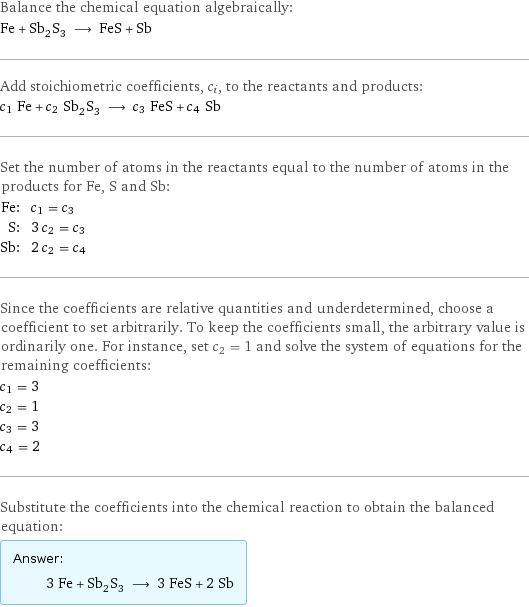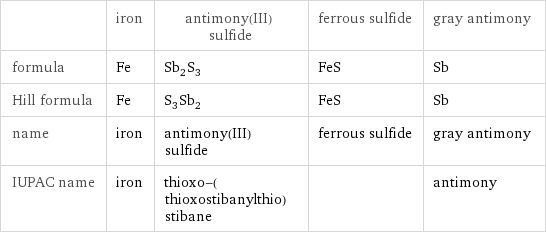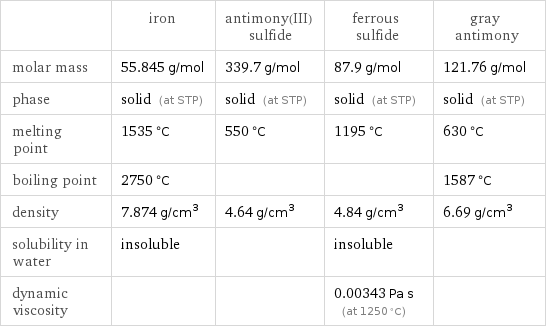Input interpretation

Fe iron + Sb_2S_3 antimony(III) sulfide ⟶ FeS ferrous sulfide + Sb gray antimony
Balanced equation

Balance the chemical equation algebraically: Fe + Sb_2S_3 ⟶ FeS + Sb Add stoichiometric coefficients, c_i, to the reactants and products: c_1 Fe + c_2 Sb_2S_3 ⟶ c_3 FeS + c_4 Sb Set the number of atoms in the reactants equal to the number of atoms in the products for Fe, S and Sb: Fe: | c_1 = c_3 S: | 3 c_2 = c_3 Sb: | 2 c_2 = c_4 Since the coefficients are relative quantities and underdetermined, choose a coefficient to set arbitrarily. To keep the coefficients small, the arbitrary value is ordinarily one. For instance, set c_2 = 1 and solve the system of equations for the remaining coefficients: c_1 = 3 c_2 = 1 c_3 = 3 c_4 = 2 Substitute the coefficients into the chemical reaction to obtain the balanced equation: Answer: | | 3 Fe + Sb_2S_3 ⟶ 3 FeS + 2 Sb
Structures

+ ⟶ +
Names

iron + antimony(III) sulfide ⟶ ferrous sulfide + gray antimony
Equilibrium constant
![Construct the equilibrium constant, K, expression for: Fe + Sb_2S_3 ⟶ FeS + Sb Plan: • Balance the chemical equation. • Determine the stoichiometric numbers. • Assemble the activity expression for each chemical species. • Use the activity expressions to build the equilibrium constant expression. Write the balanced chemical equation: 3 Fe + Sb_2S_3 ⟶ 3 FeS + 2 Sb Assign stoichiometric numbers, ν_i, using the stoichiometric coefficients, c_i, from the balanced chemical equation in the following manner: ν_i = -c_i for reactants and ν_i = c_i for products: chemical species | c_i | ν_i Fe | 3 | -3 Sb_2S_3 | 1 | -1 FeS | 3 | 3 Sb | 2 | 2 Assemble the activity expressions accounting for the state of matter and ν_i: chemical species | c_i | ν_i | activity expression Fe | 3 | -3 | ([Fe])^(-3) Sb_2S_3 | 1 | -1 | ([Sb2S3])^(-1) FeS | 3 | 3 | ([FeS])^3 Sb | 2 | 2 | ([Sb])^2 The equilibrium constant symbol in the concentration basis is: K_c Mulitply the activity expressions to arrive at the K_c expression: Answer: | | K_c = ([Fe])^(-3) ([Sb2S3])^(-1) ([FeS])^3 ([Sb])^2 = (([FeS])^3 ([Sb])^2)/(([Fe])^3 [Sb2S3])](../image_source/e4a2161a2068b671fbf232e2becfe302.png)
Construct the equilibrium constant, K, expression for: Fe + Sb_2S_3 ⟶ FeS + Sb Plan: • Balance the chemical equation. • Determine the stoichiometric numbers. • Assemble the activity expression for each chemical species. • Use the activity expressions to build the equilibrium constant expression. Write the balanced chemical equation: 3 Fe + Sb_2S_3 ⟶ 3 FeS + 2 Sb Assign stoichiometric numbers, ν_i, using the stoichiometric coefficients, c_i, from the balanced chemical equation in the following manner: ν_i = -c_i for reactants and ν_i = c_i for products: chemical species | c_i | ν_i Fe | 3 | -3 Sb_2S_3 | 1 | -1 FeS | 3 | 3 Sb | 2 | 2 Assemble the activity expressions accounting for the state of matter and ν_i: chemical species | c_i | ν_i | activity expression Fe | 3 | -3 | ([Fe])^(-3) Sb_2S_3 | 1 | -1 | ([Sb2S3])^(-1) FeS | 3 | 3 | ([FeS])^3 Sb | 2 | 2 | ([Sb])^2 The equilibrium constant symbol in the concentration basis is: K_c Mulitply the activity expressions to arrive at the K_c expression: Answer: | | K_c = ([Fe])^(-3) ([Sb2S3])^(-1) ([FeS])^3 ([Sb])^2 = (([FeS])^3 ([Sb])^2)/(([Fe])^3 [Sb2S3])
Rate of reaction
![Construct the rate of reaction expression for: Fe + Sb_2S_3 ⟶ FeS + Sb Plan: • Balance the chemical equation. • Determine the stoichiometric numbers. • Assemble the rate term for each chemical species. • Write the rate of reaction expression. Write the balanced chemical equation: 3 Fe + Sb_2S_3 ⟶ 3 FeS + 2 Sb Assign stoichiometric numbers, ν_i, using the stoichiometric coefficients, c_i, from the balanced chemical equation in the following manner: ν_i = -c_i for reactants and ν_i = c_i for products: chemical species | c_i | ν_i Fe | 3 | -3 Sb_2S_3 | 1 | -1 FeS | 3 | 3 Sb | 2 | 2 The rate term for each chemical species, B_i, is 1/ν_i(Δ[B_i])/(Δt) where [B_i] is the amount concentration and t is time: chemical species | c_i | ν_i | rate term Fe | 3 | -3 | -1/3 (Δ[Fe])/(Δt) Sb_2S_3 | 1 | -1 | -(Δ[Sb2S3])/(Δt) FeS | 3 | 3 | 1/3 (Δ[FeS])/(Δt) Sb | 2 | 2 | 1/2 (Δ[Sb])/(Δt) (for infinitesimal rate of change, replace Δ with d) Set the rate terms equal to each other to arrive at the rate expression: Answer: | | rate = -1/3 (Δ[Fe])/(Δt) = -(Δ[Sb2S3])/(Δt) = 1/3 (Δ[FeS])/(Δt) = 1/2 (Δ[Sb])/(Δt) (assuming constant volume and no accumulation of intermediates or side products)](../image_source/f4c1f92971559add970dc627d2056990.png)
Construct the rate of reaction expression for: Fe + Sb_2S_3 ⟶ FeS + Sb Plan: • Balance the chemical equation. • Determine the stoichiometric numbers. • Assemble the rate term for each chemical species. • Write the rate of reaction expression. Write the balanced chemical equation: 3 Fe + Sb_2S_3 ⟶ 3 FeS + 2 Sb Assign stoichiometric numbers, ν_i, using the stoichiometric coefficients, c_i, from the balanced chemical equation in the following manner: ν_i = -c_i for reactants and ν_i = c_i for products: chemical species | c_i | ν_i Fe | 3 | -3 Sb_2S_3 | 1 | -1 FeS | 3 | 3 Sb | 2 | 2 The rate term for each chemical species, B_i, is 1/ν_i(Δ[B_i])/(Δt) where [B_i] is the amount concentration and t is time: chemical species | c_i | ν_i | rate term Fe | 3 | -3 | -1/3 (Δ[Fe])/(Δt) Sb_2S_3 | 1 | -1 | -(Δ[Sb2S3])/(Δt) FeS | 3 | 3 | 1/3 (Δ[FeS])/(Δt) Sb | 2 | 2 | 1/2 (Δ[Sb])/(Δt) (for infinitesimal rate of change, replace Δ with d) Set the rate terms equal to each other to arrive at the rate expression: Answer: | | rate = -1/3 (Δ[Fe])/(Δt) = -(Δ[Sb2S3])/(Δt) = 1/3 (Δ[FeS])/(Δt) = 1/2 (Δ[Sb])/(Δt) (assuming constant volume and no accumulation of intermediates or side products)
Chemical names and formulas

| iron | antimony(III) sulfide | ferrous sulfide | gray antimony formula | Fe | Sb_2S_3 | FeS | Sb Hill formula | Fe | S_3Sb_2 | FeS | Sb name | iron | antimony(III) sulfide | ferrous sulfide | gray antimony IUPAC name | iron | thioxo-(thioxostibanylthio)stibane | | antimony
Substance properties

| iron | antimony(III) sulfide | ferrous sulfide | gray antimony molar mass | 55.845 g/mol | 339.7 g/mol | 87.9 g/mol | 121.76 g/mol phase | solid (at STP) | solid (at STP) | solid (at STP) | solid (at STP) melting point | 1535 °C | 550 °C | 1195 °C | 630 °C boiling point | 2750 °C | | | 1587 °C density | 7.874 g/cm^3 | 4.64 g/cm^3 | 4.84 g/cm^3 | 6.69 g/cm^3 solubility in water | insoluble | | insoluble | dynamic viscosity | | | 0.00343 Pa s (at 1250 °C) |
Units
